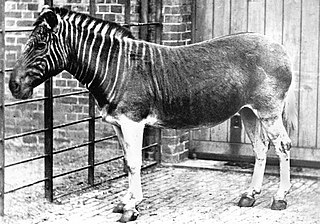
The quagga is a subspecies of the plains zebra that was endemic to South Africa until it was hunted to extinction in the late 19th century by European settler-colonists. It was long thought to be a distinct species, but early genetic studies have supported it being a subspecies of plains zebra. A more recent study suggested that it was the southernmost cline or ecotype of the species.
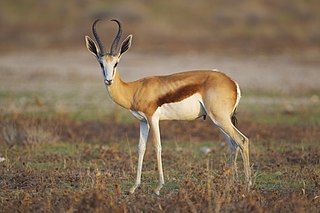
The springbok is a medium-sized antelope found mainly in southern and southwestern Africa. The sole member of the genus Antidorcas, this bovid was first described by the German zoologist Eberhard August Wilhelm von Zimmermann in 1780. Three subspecies are identified. A slender, long-legged antelope, the springbok reaches 71 to 86 cm at the shoulder and weighs between 27 and 42 kg. Both sexes have a pair of black, 35-to-50 cm (14-to-20 in) long horns that curve backwards. The springbok is characterised by a white face, a dark stripe running from the eyes to the mouth, a light-brown coat marked by a reddish-brown stripe that runs from the upper fore leg to the buttocks across the flanks like the Thomson's gazelle, and a white rump flap.
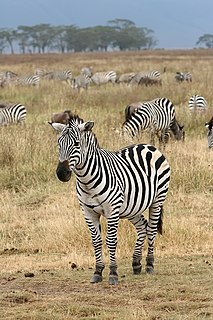
Zebras are African equines with distinctive black-and-white striped coats. There are three living species: the Grévy's zebra, plains zebra, and the mountain zebra. Zebras share the genus Equus with horses and asses, the three groups being the only living members of the family Equidae. Zebra stripes come in different patterns, unique to each individual. Several theories have been proposed for the function of these stripes, with most evidence supporting them as a deterrent for biting flies. Zebras inhabit eastern and southern Africa and can be found in a variety of habitats such as savannahs, grasslands, woodlands, shrublands, and mountainous areas.
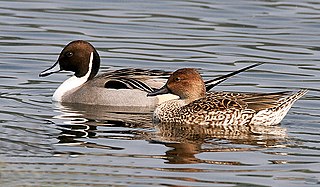
The pintail or northern pintail is a duck species with wide geographic distribution that breeds in the northern areas of Europe and across the Palearctic and North America. It is migratory and winters south of its breeding range to the equator. Unusually for a bird with such a large range, it has no geographical subspecies if the possibly conspecific duck Eaton's pintail is considered to be a separate species.

The plains zebra, also known as the common zebra, is the most common and geographically widespread species of zebra. Its range is fragmented, but spans much of southern and eastern Africa south of the Sahara. Six or seven subspecies have been recognised, including the extinct quagga which was thought to be a separate species. More recent research supports variations in zebra populations being clines rather than subspecies.

The hooded merganser is a species of merganser. It is the only extant species in the genus Lophodytes. The genus name derives from the Greek language: lophos meaning 'crest', and dutes meaning 'diver'. The bird is striking in appearance; both sexes have crests that they can raise or lower, and the breeding plumage of the male is handsomely patterned and coloured. The hooded merganser has a sawbill but is not classified as a typical merganser.

The sharp-tailed sandpiper is a small wader.

The woodland kingfisher is a tree kingfisher that is widely distributed in Africa south of the Sahara.

The bushbuck is a common and a widespread species of antelope in Sub-Saharan Africa. Bushbuck are found in a wide range of habitats, such as rain forests, montane forests, forest-savanna mosaic, savanna, bushveld and woodland. Bushbuck stand about 90 centimetres (35 in) at the shoulder and weigh from 45 to 80 kilograms. They are generally solitary, territorial browsers.

The least chipmunk is the smallest species of chipmunk and the most widespread in North America.

The spotted linsang is a linsang, a tree-dwelling carnivorous mammal, native to much of Southeast Asia. It is widely, though usually sparsely, recorded, and listed as Least Concern on the IUCN Red List.

The brown-throated sloth is a species of three-toed sloth found in the Neotropical realm of Central and South America.

The stripe-necked mongoose is a mongoose species native to forests and shrublands from southern India to Sri Lanka.

The Brazilian big-eyed bat is a species of phyllostomid bat from South America. The scientific name honours Italian naturalist Giacomo Doria.

The pyjama shark or striped catshark is a species of catshark, and part of the family Scyliorhinidae, endemic to the coastal waters of South Africa. This abundant, bottom-dwelling species can be found from the intertidal zone to a depth of around 100 m (330 ft), particularly over rocky reefs and kelp beds. With a series of thick, parallel, dark stripes running along its stout body, the pyjama shark has an unmistakable appearance. It is additionally characterized by a short head and snout with a pair of slender barbels that do not reach the mouth, and two dorsal fins that are placed far back on the body. It can grow up to a length of 1.1 m (3.6 ft) long.

The short-eared rock-wallaby is a species of rock-wallaby found in northern Australia, in the northernmost parts of the Northern Territory and Western Australia. It is much larger than its three closest relatives, the eastern short-eared rock-wallaby, the nabarlek and the monjon.

The slippery dick is a species of wrasse native to shallow, tropical waters of the western Atlantic Ocean.

The white-browed sparrow-weaver is a predominantly brown, sparrow-sized bird found throughout central and north-central southern Africa. It is found in groups of two to eleven individuals consisting of one breeding pair and other non-reproductive individuals.
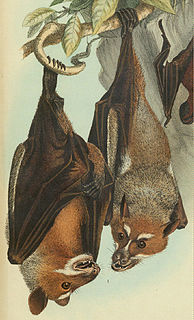
The Wallace's or Sulawesi stripe-faced fruit bat is a species of megabat in the family Pteropodidae. It is endemic to Sulawesi and the nearby Togian Islands of Indonesia. Cave paintings resembling these bats have been found in Australia, where bats of this kind are not otherwise known.
Ostorhinchus brevispinis is a species of deep-water cardinalfish. To date it has only been recorded from Rurutu in the Austral Islands and Rangiroa in the Tuamotus although the difficulty in observing and collecting this fish has led the authors who described the species to predict that it is likely to have a far wider distribution.


















